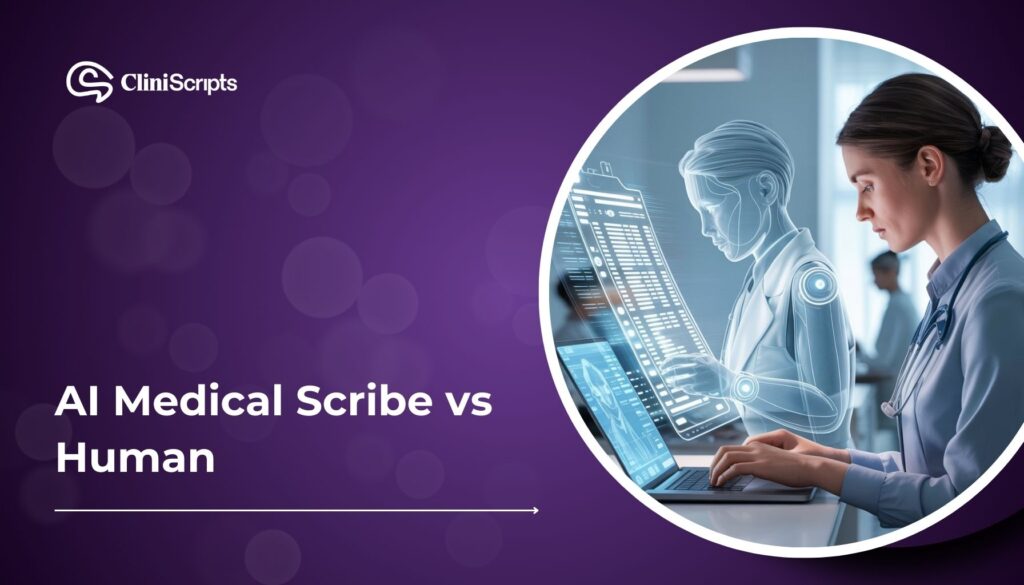Technically Reviewed By Nauman Jaffar
AI Medical Scribe vs Human: Transforming Healthcare Documentation with AI
In today’s fast-paced healthcare environment, efficiency and accuracy are paramount. One of the latest innovations revolutionizing clinical documentation is the AI medical scribe. But how does it compare to traditional human scribes? Let’s explore the differences and understand why AI-powered scribing solutions are becoming a game-changer for mental health professionals and general healthcare providers.
What Is an AI Medical Scribe?
An AI medical scribe is an advanced technological solution that assists healthcare providers by transcribing audio to text and documenting medical information in real-time. Unlike human scribes, AI scribes leverage machine learning and natural language processing (NLP) to convert verbal interactions between physicians and patients into accurate documentation. This is particularly valuable for mental health professionals who often need to complete detailed therapy notes or conduct a mental status exam.
AI Medical Scribe vs Human: Key Differences
Speed and Efficiency:
AI medical scribes work faster than humans, documenting patient interactions, including biopsychosocial assessments or therapy notes, in real-time. While human scribes may need time to transcribe, AI scribes can instantly generate accurate reports, such as SOAP notes or Da notes, allowing mental health professionals to spend more time with their patients.
Cost-Effectiveness:
AI scribes significantly reduce the overall cost of clinical documentation. While human scribes come with a salary and benefits, AI scribes can be used around the clock without additional costs, allowing for better documentation efficiency, particularly for high-volume practices.
Accuracy and Consistency:
AI scribes are programmed to follow strict documentation protocols, ensuring high consistency in therapy notes, SOAP note exams, and mental status exams, while also eliminating human error.
Availability and Flexibility:
AI medical scribes work 24/7, offering unmatched flexibility for busy healthcare providers. Human scribes, in contrast, may not be available during every shift, but AI scribes can handle documentation at any time, especially for practices dealing with high volumes of patient data.
Workflow Optimization with AI Medical Scribes
AI technology has made incredible strides in optimizing the workflow of medical professionals. With AI medical scribes, doctors and healthcare providers can focus more on patient care and less on administrative tasks. By integrating AI scribes into a hospital or clinic’s workflow, the documentation process becomes seamless, reducing the time spent on paperwork and improving patient interaction.
Benefits of AI Scribe in Workflow Optimization
-
Faster Documentation: AI scribes generate therapy notes and other documents, such as SOAP note exams, Birp notes, and therapy intake forms, in real-time, reducing the time spent entering patient data.
-
Improved Physician-Patient Interaction: Since AI scribes handle clinical documentation, physicians can focus more on their patients.
-
Reduced Administrative Burden: AI scribes take over time-consuming documentation tasks, allowing healthcare providers to handle more important matters.
-
Enhanced Data Accuracy: By automating the process, AI scribes reduce human error, ensuring accurate medical records and streamlined workflows.
AI Medical Scribe Technology Advancements
The evolution of AI medical scribe technology has been remarkable. Early iterations were basic, but today’s AI medical scribes are more sophisticated, using natural language processing (NLP) to accurately transcribe therapy notes, mental status exams, and even complex ICD-10 codes for anxiety or PTSD.
Notable Advancements:
-
Integration with EHR Systems: AI scribes are now integrated with Electronic Health Records (EHR) systems, making documentation more streamlined and less prone to errors.
-
Enhanced Learning Capabilities: AI scribes continuously improve by learning from previous medical documentation, ensuring better transcription accuracy with each interaction.
-
Voice Recognition: Advances in voice recognition technology allow AI scribes to understand medical terminology, accents, and variations in speech patterns, making them highly effective at transcribing therapy aid and medical scribe sessions in real-time.
AI Scribe vs Virtual Scribe: What’s the Difference?
A virtual scribe refers to a remote human scribe who assists healthcare providers by transcribing therapy notes during patient consultations. While both AI and virtual scribes serve the same purpose, there are key distinctions:
-
Human Element: Virtual scribes are humans who work remotely, while AI scribes are fully automated, machine-driven solutions.
-
Cost: Virtual scribes require compensation, whereas AI scribes incur lower long-term costs after initial implementation.
-
Availability: Virtual scribes are available during set hours, whereas AI scribes work 24/7 without interruptions.
AI Scribe in Medical Documentation: How It Works
AI-powered medical documentation has transformed the accuracy, speed, and efficiency of healthcare providers. By integrating AI scribes into their practice, medical professionals can save valuable time while improving patient care. AI scribes record and transcribe every word during patient consultations, converting them into comprehensive medical notes such as SOAP notes, therapy intake, or biopsychosocial assessments.
How AI Scribes Improve Documentation:
-
Real-Time Transcription: AI scribes document patient interactions, including mental status exams, in real-time, reducing errors and allowing for more accurate medical records.
-
Automatic Updates: AI scribes can instantly update patient records, reducing the time spent on manual data entry and ensuring all information is current.
-
Seamless Integration: AI scribes integrate directly with healthcare systems, automatically populating patient data into electronic health records (EHR).
Why AI Medical Scribes Are the Future of Healthcare Documentation
AI medical scribes represent the future of clinical documentation. With faster, more accurate, and more cost-effective solutions, they help healthcare professionals work smarter, not harder. As the technology continues to advance, we can expect AI scribes to become even more integrated into medical practices, ultimately leading to better patient outcomes and more efficient healthcare systems.










